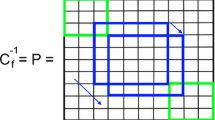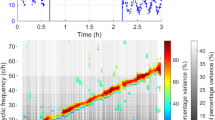Abstract
This paper presents an edge detecting filter, known as “the weak elastic string”, and some of its possible applications in locating slips and outliers in geodetic time series. Basically, the weak elastic string is a mechanical rather than a stochastic filter. It is based on the concept of a weak continuity constraint, that is, a constraint that prefers the continuity of a function, but allows for occasional discontinuities if they simplify the overall description of the function. The performance of the filter is controlled by a few parameters that tune the filtering to the noise level in the data. Unlike methods based on statistical testing, the efficiency of the weak elastic string depends on the noise level. If the data are precise, the algorithm is extremely efficient due to its mechanical nature. In addition, the filter does not require mathematical modeling of the shape of the data. The algorithm is applied to edit time series of completely different nature: satellite altimetry sea surface heights and combinations of GPS phase and pseudo-range data. Finally, the filter is incorporated in the linear least squares estimator resulting in a completely geometric, robust and efficient least squares algorithm.
Similar content being viewed by others
References
Al-Tahir R. and T. Schenk (1992). On the interpolation problem of automated surface reconstruction.International Archives of Photogrammetry and Remote Sensing, Washington D.C., Commission III.
Blake A. (1983). The least disturbance principle and weak constraints.Pattern Recognition Letters, 1, pp. 393–399.
Blake A. and A. Zisserman (1987).Visual Reconstruction, MIT Press, Cambridge, USA.
Blewitt G. (1990). An automatic editing algorithm for GPS data.Geophysical Research Letters, Vol. 17, No.3, pp. 199–202.
Denker H. (1990). Radial orbit error reduction and sea surface topography determination using one year of GEOSAT altimeter data.Report No. 404, Department of Geodetic Science, The Ohio State University, Columbus, Ohio.
Euler H.J. and C.C. Goad (1991). On optimal filtering of GPS Dual frequency observations without using orbit information.Bulletin Geodesique. Vol. 65, No. 2, pp. 130–143.
Fetter A.L. and J.D. Walecka (1980).Theoretical Mechanics of Particles and Continua. McGraw-Hill, New York.
Goad C.C. (1986). Precise positioning with the Global Positioning System.Proceedings of the Third International Symposium on Inertial Technology for Surveying and Geodesy. Surveying Engineering, University of Calgary, Publication 6005, Alberta, Canada.
Goad C.C. (1990). Optimal filtering of Pseudoranges and phases from single-frequency GPS receivers.Navigation, Vol. 37, No. 3, pp. 249–261.
Goad C.C. (1992). Robust Techniques for determining GPS phase ambiguities.Proceedings of the Sixth International Geodetic Symposium on Satellite Positioning. The Ohio State University, Columbus, Ohio.
Teunissen P.J.G. and M.A. Salzmann (1989). A recursive slippage test for use in state-space filteringManuscripta Geodaetica, Vol. 14, pp. 383–390.
Teunissen P.J.G. (1990). Quality control in integrated navigation systems.IEEE Aerospace and Electronic Systems Magazine, Vol. 5, No. 7, pp. 35–41.
Author information
Authors and Affiliations
Rights and permissions
About this article
Cite this article
Saleh, J. The weak elastic string and some applications in geodesy. Journal of Geodesy 70, 203–213 (1996). https://doi.org/10.1007/BF00873701
Received:
Accepted:
Issue Date:
DOI: https://doi.org/10.1007/BF00873701




